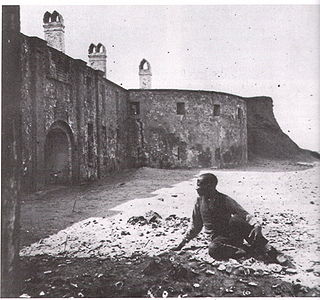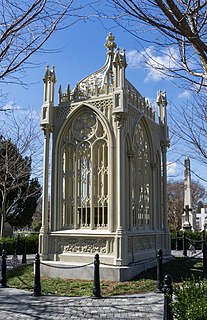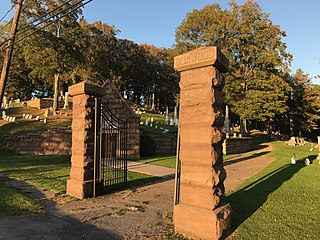
Castle Pinckney was a small masonry fortification constructed by the United States government by 1810, in the harbor of Charleston, South Carolina. It was used very briefly as a prisoner-of-war camp and artillery position during the American Civil War. It was named to the National Register of Historic Places in 1970.

The James Monroe Tomb is the burial place of United States President James Monroe in Hollywood Cemetery, Richmond, Virginia, United States. The principal feature of the tomb is an architecturally unusual cast iron cage, designed by Albert Lybrock and installed in 1859, after Monroe's body was moved from Marble Cemetery in New York City. It was declared a National Historic Landmark in 1971 for its unique architecture. It has been given the local nickname of "The Birdcage".

St. Mark's Cemetery is a historic cemetery located on E. Main Street on the corner of St. Mark's Place in Mount Kisco, Westchester County, New York. The earliest section was established in 1761, and the earliest gravestone to 1773. The last burial was in 1940. The cemetery served as a burial ground for two religious denominations, Revolutionary War soldiers, and local citizens. It served as the site of a temporary army hospital during the Battle of White Plains.

Oakwood Cemetery in Niagara Falls, New York was founded in 1852 after land was donated by Lavinia Porter. It covers over 18 acres (1 km²) and over 19,000 are buried there. Notable graves include first person to travel over Niagara Falls in a barrel Annie Edson Taylor, Judge Augustus Porter, and first person to swim the English Channel Captain Matthew Webb. In 2014 it was listed on the National Register of Historic Places.

Pioneer Cemetery, also known as Evans Center Cemetery, is a historic cemetery located at Evans Center in Erie County, New York. It consists of 10 to 11 rows of burials, with the oldest dating to 1810. The majority of the burials date between 1810 and 1860, with the most recent burial in 1928. Most are marked with simple tablet headstones. It features hilly terrain with a prominent rise at the center of the cemetery.

Jonesville is a hamlet in Saratoga County, New York, United States.

Hampton–Pinckney Historic District is a national historic district located at Greenville, South Carolina. It encompasses 70 contributing buildings in a residential section of Greenville. The houses date from about 1890 to 1930, and include Italianate, Greek Revival, Queen Anne, various bungalows, and examples of Gothic Revival and Colonial Revival design, as well as vernacular forms. The oldest house in the district is the McBee House.

Beddoe–Rose Family Cemetery is a historic cemetery located in Keuka Lake State Park at Jerusalem in Yates County, New York. It was established about 1815, and is a settlement era burial ground containing the graves of 14 members of the Beddoe and Rose families. The cemetery remained an active burial ground until 1908. The farm property was acquired for Keuka Lake State Park in the 1950s and the farmhouse subsequently demolished.

Riverside Cemetery is a historic cemetery located near Lowman, Chemung, Chemung County, New York. It was established in the 1790s, and contains graves dating from then to the present. It has a cast iron gate archway inscribed "Riverside Cemetery" and dated to about 1900. The cemetery includes the graves of many early settlers and Revolutionary War soldiers. Notable burials include Lieutenant Governor Seymour Lowman (1868-1940).

Meetinghouse Green Road Cemetery is a historic cemetery located at Meetinghouse Green in Herkimer County, New York. It was established about 1801 and contains about 140 marked burials. The most recent burial dates to 1967. Headstones include simple grave markers through large and ornate carved and cast monuments.

Stewart House and Howard–Stewart Family Cemetery is a historic home and family cemetery located in Jefferson, Schoharie County, New York. It was built about 1857, and is a two-story, "T"-plan Greek Revival style timber frame farmhouse with a 1 1/2-story side wing. It is sheathed in clapboard, has a front gable roof, and Doric order corner pilasters. Also on the property is a contributing family cemetery with burials dated from 1828 to 1881.

Terpenning–Johnson House and Cemetery is a historic home and family cemetery located at Brooker Hollow, Schoharie County, New York. The main block was built about 1845, and is a two-story, five bay, dwelling with a 1 1/2-story side wing built about 1810. Both sections have gable roofs rest on a stone foundation. Also on the property are the contributing family cemetery with burials dated from 1812 to 1873, garage, workshop, and barn (1840s).

St. Paul's Lutheran Church Historic District, also known as Schoharie United Presbyterian Church, is a historic Lutheran church complex and national historic district located at Schoharie, Schoharie County, New York. The complex consists of the former St. Paul's Lutheran Church, an 1801 manse, St. Paul's Lutheran Cemetery, and the old Lutheran Parsonage. The church was built in 1796, and is a two-story rectangular brick building. The front facade features a square, multistage entrance tower capped by an octagonal belfry and spire. The new manse was built in 1801, and is a five bay, two-story, double pile, heavy timber frame Federal style dwelling with a two-story rear ell. The church cemetery has several thousand graves, with the earliest marked grave dated to 1778. The Old Lutheran Parsonage was built in 1743, and is separately listed. In 1920, the local Lutheran and Methodist congregations joined, and in 1960, the congregation voted to affiliate with the Presbyterian denomination.

Jonesville Cemetery is a historic rural cemetery located at Jonesville, Saratoga County, New York. The cemetery was established in 1864, and designed by Burton A. Thomas. It includes the remains of 252 individuals who were relocated early in the cemetery's history and date between 1799 and 1863. It remains an active burial ground.

Hartsdale Pet Cemetery, also known as Hartsdale Canine Cemetery, is a historic pet cemetery located at Hartsdale, Westchester County, New York. It was established in 1896, and contains over 70,000 interments, with 14,000 interment lots and 7,000 memorials. Contributing resources include the groundskeeper's cottage, a house, a public memorial to the dogs of war, a mausoleum, and manmade and natural topographical attributes. It is America's largest and oldest pet cemetery.

Boxwood Cemetery is a historic rural cemetery located at Medina in Orleans County, New York. The cemetery was established in 1849, and is the resting place of many early settlers. The cemetery includes approximately 5,000 marked burials in the cemetery, spanning from 1849 until the present day. It features entranceways flanked by Medina sandstone columns and wrought-iron gates built in 1925. Located in the cemetery is a Gothic Revival style chapel built in 1903 of rough-cut red Medina sandstone.

Riverside Cemetery is a historic cemetery located near Apalachin in Tioga County, New York. It was established in 1802, with late-19th century additions and an addition in 1939. It remains an active burial ground containing approximately 3,600 burials. It is the final resting place of many early settlers of the region. A set of stone entrance gates were installed in 1939. Notable burials include May Louise Davison Purple (1871-1957), wife of author Eugene Manlove Rhodes.

Collinsville Cemetery is a historic cemetery located near West Turin in Lewis County, New York. It was established in 1810. It remains an active burial ground containing approximately 380 marked burials. It is the final resting place of many early settlers of the region. A number of the markers include verse epitaphs.

Dunning Street Cemetery is a historic rural cemetery located at Malta, Saratoga County, New York. The cemetery was established about 1775, and incorporated by the Dunning Street Cemetery Association in 1908. It is the final resting place of many important early Malta residents, including veterans of American Revolutionary War and includes a number of notable examples of 19th century local funerary art. It remains an active burial ground.

South Salem Presbyterian Church Cemetery is a historic home located at South Salem, Westchester County, New York. The cemetery was established in the 18th century, perhaps as early as 1710. It has a total of 373 identified graves, ranging in date from 1739 to 1928. Burials include veterans of the French and Indian War, Revolutionary War and War of 1812. It includes a number of notable 18th and 19th century grave markers.



















